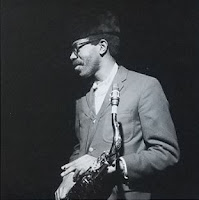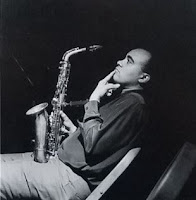Grant Green - Solid
Released - 1979
Recording and Session Information
Van Gelder Studio, Englewood Cliffs, NJ, June 12, 1964
James Spaulding, alto sax; Joe Henderson, tenor sax; McCoy Tyner, piano; Grant Green, guitar; Bob Cranshaw, bass; Elvin Jones, drums.
tk.3 Grant's Tune
tk.14 Minor League
tk.28 The Kicker
tk.35 Ezz-Thetic
tk.37 Solid
Session Photos
Photos: © Francis Wolff/Mosaic Images https://www.mosaicrecordsimages.com/
Track Listing
| Side One | ||
| Title | Author | Recording Date |
| Minor League | D. Pearson | June 12 1964 |
| Ezz-Thetic | G. Russell | June 12 1964 |
| Side Two | ||
| Grant's Tune | G. Green | June 12 1964 |
| Solid | S. Rollins | June 12 1964 |
| The Kicker | J. Henderson | June 12 1964 |
Liner Notes
GRANT GREEN
The tragedy of Grant Green’s death in early 1979 was compounded by the fact that his recorded output for the last decade or more of his life was, for the most part, commercial, uncreative and lacking in individuality. He deserved better, but the economics of keeping a band working and holding down a record contract forced him into situations far below his talent.
Fortunately, Blue Note thoroughly documented his artistry on a number of sessions under Grant’s leadership in the early sixties. Moreover, he was the resident guitarist for Blue Note’s stable of premier organists such as Jimmy Smith, John Patton and Larry Young and participated in dates by Lee Morgan, Horace Parlan, Don Wilkerson, Lou Donaldson and others.
Unknown outside of his hometown St. Louis except through his Delmark recording with tenor saxophonist Jimmy Forrest, Grant was brought to the label and to New York in 1960 by Lou Donaldson. Blue Note always operated on a family basis, developing an impressive, cross-fertilizing repetory group of musicians. Grant was quickly and fully instated in mid 1960.
Green represented not only a fresh, vibrant new voice on an instrument that had become rather sleepy in style in the fifties, but he was also a major link with the all too often neglected pioneer of the hollow body electric guitar in jazz, Charlie Christian. Grant executed bright, clean lines that never fully abandoned the melody, emphasized concise, linear, single note improvisations and possessed a unique rhythmic momentum that remains unmatched. He absorbed Christian, then bypassed such heroes of the day as Tal Farlow, Kenny Burrell and Wes Montgomery and moved directly to the formation of his own identity.
Over the years, a surprising amount of fine sessions by Green amassed in the Blue Note vaults. One such session was a quarter date from May, 1964 with McCoy Tyner, Bob Cranshaw and Elvin Jones. As the driving forces of the John Coltrane quarter, McCoy and Elvin brought new texture and drive to Grant’s music. The resultant album Matador was finally issued on Blue Note in Japan in mid 1979.
The results must have been satisfying to all concerned because Blue Note brought Grant into the studio again on June 12 with the same rhythm section and saxophonists Joe Henderson and James Spaulding added. Because Tyner and Jones are so pivotal to the sound of the group, it is interesting to note that these sessions took place shortly after Coltrane recorded his masterpiece Crescent.
Later in 1964, Grant and Elvin would team with organist Larry Young to become a very special rhythm section that was responsible for a number of Blue Note dates.
Joe Henderson was brought into the Blue Note fold in 1963 by Kenny Dorham. He soon had his own recording contract and popped up frequently as a sideman on dates by Andrew Hill, Freddie Roach, Lee Morgan and others. One month after this Grant Green session. he joined Horace Silvers new band.
James Spaulding, a fiery alto saxophonist and perfect flutist, was introduced on Blue Note with Freddie Hubbard’s first working band. He too has enhanced dozens of Blue Note sessions by other artists, although he never recorded for the label as a leader.
The album opens with Minor League. one of Duke Pearson’s finest tunes, which he later recorded with his own big band. Spaulding solos first, and he comes out of the corner burning as usual. This is a rhythm section that certainly has no problem keeping up with him. Grant, Joe and McCoy solo in that order. It is clear from the outset that everyone is improvising with thought and creativity on this date.
Ezz-Thetic is one of several fascinating jazz classics by the great composer George Russell, whose concepts of playing within the Lydian Mode have had a far reaching influence. Ezz-Thetic has an interesting history of beautiful performances that began with Lee Konitz’ classic Prestige date, which included Miles Davis. In 1956, Max Roach recorded a fine version for Mercury with Sonny Rollins featured. Russell himself recorded it in 1956 on RCA and again in 1961 on Riverside, this time with Eric Dolphy in the band. The version on this album must certainly be the most extended with fine solos from Green, Spaulding, Henderson, Tyner and Jones.
Grant’s Tune, not tomb, is an interesting Green line. Although Elvin is wailing in his triplet feel, the solos from Grant, Joe and James have a certain reserve that befits the flavor of the composition. The combination of elements works well.
Sonny Rollins’ Solid dates back to 1954 when the composer recorded it for Prestige. It is a comfortable blues, given a smooth easy performance by the band.
The Kicker by Joe Henderson became an instant classic when it appeared on Horace Silver’s Song For My Father album, recorded in October 1964. But the tune had been kicking around Blue Note for almost a year before that. In December, 1963, Bobby Hutcherson recorded it with both Joe and Grant on the date. The session was less than successful and remained in the can. Six months later, it was resurrected on this album, which of course remained unissued until now.
Too large a part of Grant Green’s legacy is dreadful at tempts at commerciality. His early Blue Note efforts preserve his best playing. And an album such as this one reminds of his creativity, intelligence and sense of challenge as a jazz musician. Solid and Matador, along’ with such classics as Idle Moments, are the albums that truly represent Green. They are the part of his legacy that will live forever.
— Michael Cuscuna
Notes for the 2012 CD Edition
Grant Green left some truly great music in the vaults at Blue Note, most notably four quartet dates with Sonny Clark and this powerful sextet date with Joe Henderson, James Spaulding, McCoy Tyner, Bob Cranshaw and Elvin Jones. My guess is that Green was having success with bluesier organ dates so pure jazz in this vein was left behind for fear that it would confuse his growing audience.
But this is one killer date with great playing and superb classic material from George Russell and Sonny Rollins as well as new originals like Joe Henderson's "The Kicker". Oddly enough, "The Kicker" seemed to be an unlucky tune for Henderson at the time. It was first recorded by Bobby Hutcherson in December 1963 session (with Grant on that date as well) but not released at the time. Then came this version with the same fate. But then, Horace Silver recorded it four months later and it was released on "Song For My Father" (4185) which remains one of the greatest selling Blue Note albums of all time:
- Michael Cuscuna








No comments:
Post a Comment